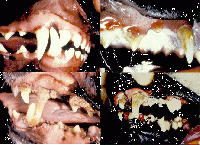|
|
| (13 intermediate revisions by the same user not shown) |
| Line 1: |
Line 1: |
| − | {{review}} | + | {{frontpage |
| | + | |pagetitle =Teeth - Pathology |
| | + | |pagebody = |
| | + | |contenttitle =Content |
| | + | |contentbody =<big><b> |
| | + | <br><br> |
| | + | <categorytree mode=pages>Teeth - Pathology</categorytree> |
| | | | |
| − | ==Introduction== | + | </b></big> |
| | + | |logo =path-logo.png |
| | + | }} |
| | | | |
| − | See [[Oral Cavity - Teeth & Gingiva - Anatomy & Physiology|anatomy and physiology of the teeth]]
| |
| | | | |
| − | ==Functional Anatomy==
| + | [[File:Toothinfection.gif|200px]] |
| | | | |
| − | *The [[Cavity & Gingiva - Pathology|gingival crevice]] is an important site for disease processes in mouth to begin.
| |
| | | | |
| − | *In ruminants and rodents [[Oral Cavity - Teeth & Gingiva - Anatomy & Physiology|teeth]] may fail to oppose properly or to allow side to side movement of jaws. This produces uneven wear (especially in horse). Sharp edges are produced on the outside of the [[Oral Cavity - Teeth & Gingiva - Anatomy & Physiology|teeth]] in the upper jaw and inside of the [[Oral Cavity - Teeth & Gingiva - Anatomy & Physiology|teeth]] in the lower jaw, which causes painful feeding and inanition (not eating).
| |
| − | **Approximately 75% of wasting horses have dental abnormalities.
| |
| − |
| |
| − | *This is not a problem in carnivores as do they not use [[Oral Cavity - Teeth & Gingiva - Anatomy & Physiology|teeth]] for [[Mastication|mastication]].
| |
| − |
| |
| − | *If a [[Oral Cavity - Teeth & Gingiva - Anatomy & Physiology|teeth]] is lost the opposing [[Oral Cavity - Teeth & Gingiva - Anatomy & Physiology|teeth]] may become very long and stop mouth closing properly.
| |
| − | **Seen mostly in rodents - [[Oral Cavity - Teeth & Gingiva - Anatomy & Physiology|teeth]] may even penetrate through [[Lips - Anatomy & Physiology|lip]].
| |
| − |
| |
| − | ==Defence Mechanisms==
| |
| − |
| |
| − | ==Developmental Pathology==
| |
| − | ===[[Erythropoietic Porphyra]].===
| |
| − |
| |
| − |
| |
| − | ===[[Photosensitisation]]===
| |
| − |
| |
| − |
| |
| − | ===[[Abnormal Wear of Teeth]]===
| |
| − |
| |
| − |
| |
| − | ===[[Abnormal Numbers of Teeth]]===
| |
| − |
| |
| − | ==Infection of teeth==
| |
| − |
| |
| − |
| |
| − |
| |
| − | ===[[Alveolar Periostitis]]===
| |
| − |
| |
| − | ==Granulomatous and pyogranulomatous Inflammation==
| |
| − | ===[[Mandibular Osteomyelitis]]===
| |
| − |
| |
| − |
| |
| − | ===Odontoclastic resorptive lesions===
| |
| − | *Cats
| |
| − | **Odontoclasts attack external and internal to the [[Oral Cavity - Teeth & Gingiva - Anatomy & Physiology|tooth]].
| |
| − | **Initially start at the neck/cervical region and extend into [[Oral Cavity - Teeth & Gingiva - Anatomy & Physiology|tooth]] [[Root - Anatomy & Physiology|root]] and also enter the [[Root - Anatomy & Physiology|root]] via the apical foramen (stage 3 lesions)
| |
| − | **20%+ of cats have them
| |
| − | **Different from caries – demineralization by bacteria fermenting CHO on the [[Enamel - Anatomy & Physiology|enamel]].
| |
| − | **ORLs – only occur when odontoclasts resorb the [[Oral Cavity - Teeth & Gingiva - Anatomy & Physiology|tooth]]/bone
| |
| − | ***continues with remodeling of [[Alveolar bone - Anatomy & Physiology|alveolar bone]] until ankylosis
| |
| − | *** fixation of [[Periodontal ligament - Anatomy & Physiology|periodontal ligament]] and [[Lamina dura - Anatomy & Physiology|lamina dura]] so that the [[Oral Cavity - Teeth & Gingiva - Anatomy & Physiology|tooth]] is permanently fixed to the bone.
| |
| − | *Odontoclasts normally only active in young animals to resorb the [[Oral Cavity - Teeth & Gingiva - Anatomy & Physiology#Temporary Tooth|deciduous teeth]] to make way for the [[Oral Cavity - Teeth & Gingiva - Anatomy & Physiology#Permanent Tooth|permanent teeth]] – so represents abnormal activation in adults.
| |
| − | *Can have inflammatory infiltrates into the resportive lesions
| |
| − |
| |
| − | ==Eosinophilic Inflammation==
| |
| − | ==Necrotizing Inflammation==
| |
| − | ==Lymphocytic and plasmacytic Inflammation==
| |
| − | ==Proliferative Pathology==
| |
| − | ===Hyperplastic===
| |
| − | ====Focal fibrous hyperplasia<ref name="epulides1"> </ref>====
| |
| − | *44% of cases.
| |
| − | *Dense collagenous tissue, with ulceration/superficial inflammation
| |
| − | *Dystrophic calcificaition within the fibrous connective tissue stroma (often highly cellular, with 'young stellate fibroblasts'
| |
| − | *No odontogenic epithelium seen.
| |
| − | *Occasional strands of surface epithelium growing down into the stroma.
| |
| − | *Most of these were previously diagnosed as fibromatous or ossifying epulides.
| |
| − |
| |
| − | ===Neoplastic===
| |
| − | ====Peripheral odontogenic fibroma<ref name="epulides1">J Comp. Path. 1992 (106), 169-182 The Histological Nature of Epulides in Dogs F. J. M. Verstraete*, A. J. Ligthelmf and A. WeberT. ... review of 154 oral 'epulis' from dogs reviewed with the current (at the time) human literature.</ref>====
| |
| − | [[Image:epulis.gif|right|thumb|125px|<small><center>Canine Epulis (Courtesy of Alun Williams (RVC))</center></small>]]
| |
| − | *aka: Fibromatous epulis of periodontal ligament origin
| |
| − | *17% of cases.
| |
| − | *Proliferation of fibrous tissue with variety of osteoid, [[Cementum - Anatomy & Physiology|cementum]] or [[Dentine - Anatomy & Physiology|dentine]]-like material.
| |
| − | *Isolated strands or islands of odontogenic epithelium always present (ie: suggesting induction of connective tissue by the epithelial cells).
| |
| − | *The stroma contains neoplastic fibroblasts, with varying cellularity.
| |
| − | *The overlying epitheluim is normal.
| |
| − |
| |
| − | ====Peripheral ameloblastoma<ref name="epulides1"> </ref>====
| |
| − | [[Image:ameloblastoma.gif|right|thumb|125px|<small><center>Ameloblastoma (Courtesy of Alun Williams (RVC))</center></small>]]
| |
| − | *aka: basal cell carcinoma, acanthomatous ameloblastoma, acanthomatous epulis
| |
| − | *18% of cases.
| |
| − | *Islands and sheets of mature odontogenic epithelium within a collagenous fibrous connective tissue stroma of low/moderate cellularity.
| |
| − | *Each of the islands bounded by a row of tall columnnar cells.
| |
| − | *These palisading cells exhibit polarisation away from the basement membrane and had cytoplasmic vacuolation.
| |
| − | *Central cells had a basaloid appearance.
| |
| − | *Often infiiltrating into the underlying bone.
| |
| − | *Synonymous with basal cell carcinoma.
| |
| − |
| |
| − | ====Central ameloblastoma<ref name="epulides1"> </ref>====
| |
| − | *Different from peripheral ameloblastoma - cystic changes and follicular arrangement of ameloblasts and stellate reticulum cells, resembling the basic structure of the [[Tooth Anatomy - Anatomy & Physiology|enamel organ]].
| |
| − |
| |
| − | ==Degenerative Pathology==
| |
| − | ===Odontodystrophy===
| |
| − |
| |
| − | *Damage to [[Ameloblasts - Anatomy & Physiology|ameloblasts]] (which form [[Enamel - Anatomy & Physiology|enamel]]) in utero upsets permanent incisor formation.
| |
| − | *[[Enamel - Anatomy & Physiology|Enamel]] is marked by pits, lines etc.
| |
| − |
| |
| − | ====In ruminants:====
| |
| − | *Damage to [[Enamel - Anatomy & Physiology|enamel]] formation most often caused by fluoride poisoning.
| |
| − | *Seen in cattle grazing on pasture contaminated by cement works effluent.
| |
| − | *Chalky mottling and yellow brown pitting of [[Oral Cavity - Teeth & Gingiva - Anatomy & Physiology|tooth]].
| |
| − |
| |
| − | ====In canines:====
| |
| − | [[Image:enamal-hypoplasia.gif|right|thumb|125px|<small>Enamal Hypoplasia Following a CDV infection (Courtesy of Alun Williams (RVC))<center></center></small>]]
| |
| − | Very severe systemic disease early in life / or in utero may result in severe discoloration or pitting of [[Oral Cavity - Teeth & Gingiva - Anatomy & Physiology|teeth]] due to effect on [[Enamel - Anatomy & Physiology|enamel]] formation. (e.g. [[Paramyxoviridae#Canine Distemper Virus (CDV)|distemper in dog]])
| |
| − |
| |
| − | ==Metabolic Pathology==
| |
| − |
| |
| − | ==Nutritiona Pathology==
| |
| − |
| |
| − | ==Traumatic Pathology==
| |
| − |
| |
| − | ==Vascular Pathology==
| |
| − | ==References==
| |
| − | <small>
| |
| − | With thanks to Andrew Jefferies (Cambridge) and Alun Williams (RVC) for providing access to their lecture materials
| |
| − | <references/>
| |
| − | </small>
| |
| − | ==Learning Tools==
| |
| − | [[Alimentary Flashcards - Pathology#Teeth Flashcards|Teeth Flashcards]]
| |
| | [[Category:Oral_Cavity_and_Gingiva_-_Pathology]] | | [[Category:Oral_Cavity_and_Gingiva_-_Pathology]] |

